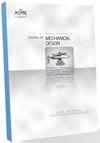ON THE USE OF GEOMETRIC DEEP LEARNING FOR THE ITERATIVE CLASSIFICATION AND DOWN-SELECTION OF ANALOG ELECTRIC CIRCUITS
IF 3
3区 工程技术
Q2 ENGINEERING, MECHANICAL
引用次数: 0
Abstract
Abstract Many complex engineering systems can be represented in a topological form, such as graphs. This paper utilizes a machine learning technique called Geometric Deep Learning (GDL) to aid designers with challenging, graph-centric design problems. The strategy presented here is to take the graph data and apply GDL to seek the best realizable performing solution effectively and efficiently with lower computational costs. This case study used here is the synthesis of analog electrical circuits that attempt to match a specific frequency response within a particular frequency range. Previous studies utilized an enumeration technique to generate 43,249 unique undirected graphs presenting valid potential circuits. Unfortunately, determining the sizing and performance of many circuits can be too expensive. To reduce computational costs with a quantified trade-off in accuracy, the fraction of the circuit graphs and their performance are used as input data to a classification-focused GDL model. Then, the GDL model can be used to predict the remainder cheaply, thus, aiding decision-makers in the search for the best graph solutions. The results discussed in this paper show that additional graph-based features are useful, favorable total set classification accuracy of 80% in using only 10% of the graphs, and iteratively-built GDL models can further subdivide the graphs into targeted groups with medians significantly closer to the best and containing 88.2 of the top 100 best-performing graphs on average using 25% of the graphs.利用几何深度学习进行模拟电路的迭代分类和下行选择
许多复杂的工程系统可以用拓扑形式表示,如图。本文利用一种称为几何深度学习(GDL)的机器学习技术来帮助设计师解决具有挑战性的、以图形为中心的设计问题。本文提出的策略是利用图数据并应用GDL,以较低的计算成本高效地寻求最佳可实现的执行解决方案。这里使用的案例研究是试图在特定频率范围内匹配特定频率响应的模拟电路的合成。先前的研究利用枚举技术生成了43,249个唯一的无向图,表示有效的电位电路。不幸的是,确定许多电路的尺寸和性能可能过于昂贵。为了减少计算成本和量化的准确性权衡,电路图的分数和它们的性能被用作以分类为中心的GDL模型的输入数据。然后,GDL模型可以用来廉价地预测剩余部分,从而帮助决策者寻找最佳的图解决方案。本文讨论的结果表明,额外的基于图的特征是有用的,仅使用10%的图,总集分类准确率就达到80%,迭代构建的GDL模型可以进一步将图细分为目标组,中位数明显接近最佳,平均使用25%的图包含前100个最佳图中的88.2个。
本文章由计算机程序翻译,如有差异,请以英文原文为准。
求助全文
约1分钟内获得全文
求助全文
来源期刊

Journal of Mechanical Design
工程技术-工程:机械
CiteScore
8.00
自引率
18.20%
发文量
139
审稿时长
3.9 months
期刊介绍:
The Journal of Mechanical Design (JMD) serves the broad design community as the venue for scholarly, archival research in all aspects of the design activity with emphasis on design synthesis. JMD has traditionally served the ASME Design Engineering Division and its technical committees, but it welcomes contributions from all areas of design with emphasis on synthesis. JMD communicates original contributions, primarily in the form of research articles of considerable depth, but also technical briefs, design innovation papers, book reviews, and editorials.
Scope: The Journal of Mechanical Design (JMD) serves the broad design community as the venue for scholarly, archival research in all aspects of the design activity with emphasis on design synthesis. JMD has traditionally served the ASME Design Engineering Division and its technical committees, but it welcomes contributions from all areas of design with emphasis on synthesis. JMD communicates original contributions, primarily in the form of research articles of considerable depth, but also technical briefs, design innovation papers, book reviews, and editorials.
 求助内容:
求助内容: 应助结果提醒方式:
应助结果提醒方式:


